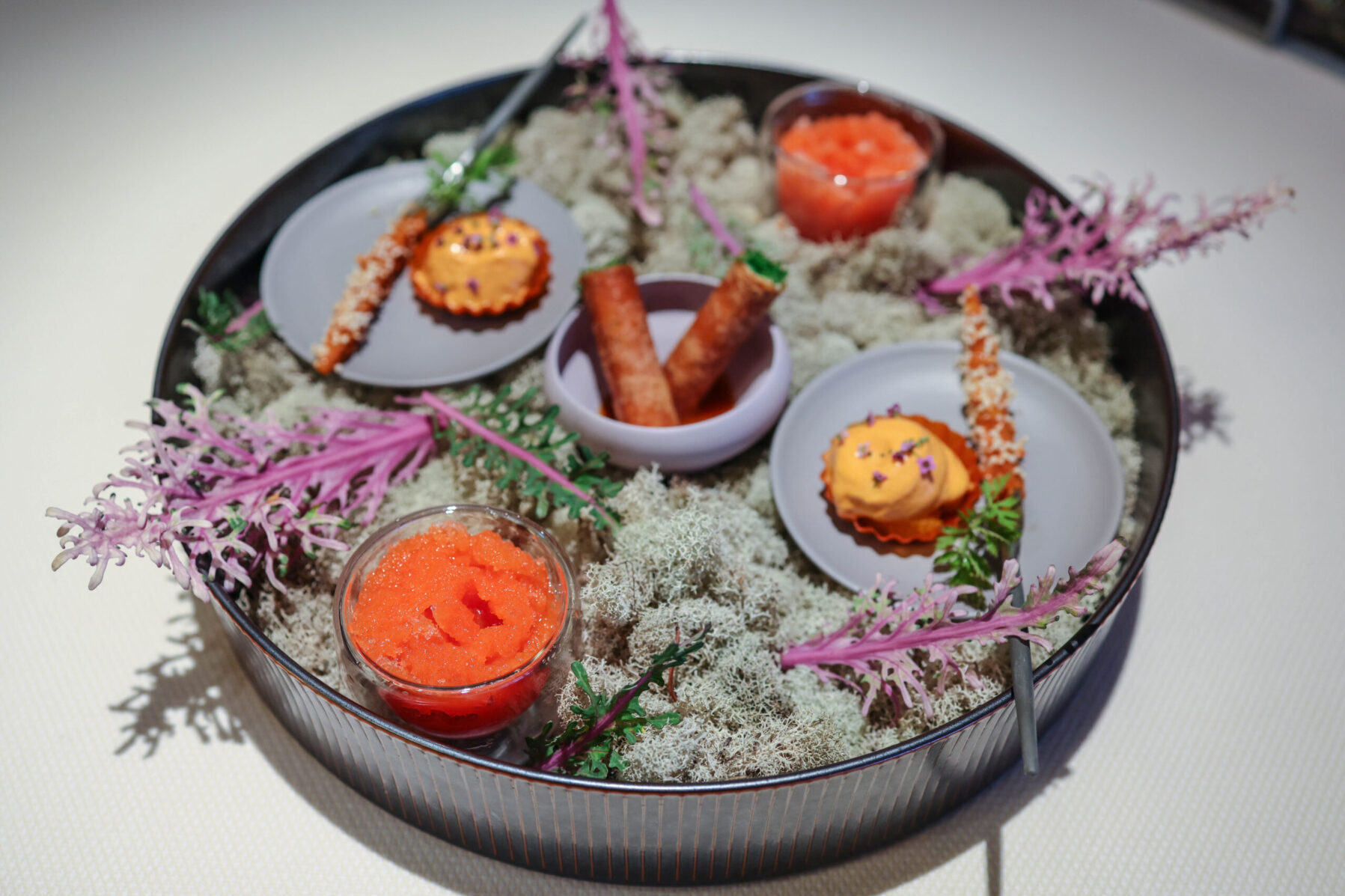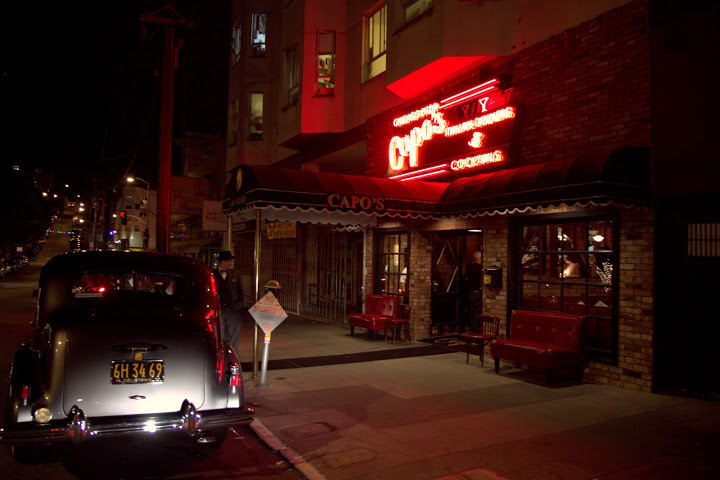
Capo’s feels as if it’s been in San Francisco for decades
Capo’s, 641 Vallejo Street, 415.986.8998, cash only
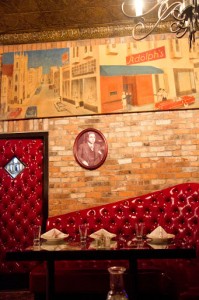
Slip into red leather bootha named after legendary Chicago mobsters
Tony’s Pizza Napoletana reigns for my best all-around pizza experience because of its range of impeccable pies, from New York to Neapolitan. I’m no stranger to these categories, consuming countless pizzas in my many travels in Italy and years living in a New Jersey suburb of NYC – not to mention living in what has become a damn great pizza town itself: San Francisco.
As an 11-time World Pizza Champion, Tony Gemignani has done the impossible: win the 2007 World Champion Pizza Maker at the World Pizza Cup in Italy, the only American and non-Neapolitan to do so. What makes Tony’s special is the painstaking detail to which each style is prepared, right down to flour and ovens used. In one restaurant, there’s authentic versions of Detroit pizza cooked in a 550 degree gas oven, or a Jersey tomato pie that could make one weep with its garlic and tomato purity.
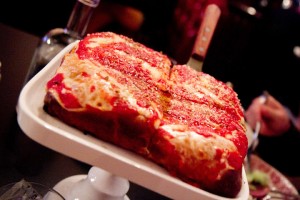
Quattro Forni: glorified bread cooked four times
Enter Capo’s (“boss” in Italian), Gemignani’s new Chicago pizza endeavor. Consulting four of Chicago’s legendary pizza families (Marc Malnati of Lou Malnati’s, Leo Spitziri of Giordano’s, Jeff Stolfe from Connie’s, Tony Troiano of JB Alberto’s), he chose three ovens (one wood-fired and two brick, heated to different degrees depending on recipe), and is the only West Coast restaurant using Ceresota flour from one of Illinois’ oldest mills, a staple of Chicago’s most revered pizzerias.
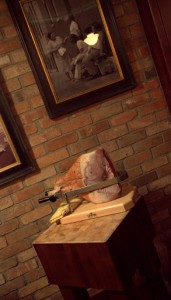
Meat sliced fresh daily
Capo’s Prohibition-era setting under pressed tin ceiling is entirely my scene. From the doorman to a stylish host, it evokes a decades old North Beach haunt, not a newcomer. Red leather booths named after Chicago mobsters (Tony Accardo, Frank Nitii, Jim Colosimo, and naturally, Al Capone), a functioning 1930’s telephone booth, a restored, 1960’s panoramic painting (found in the floor boards) of Adolf Restaurant once housed in the space… Capo’s is an ode to Chicago and San Francisco’s rich Italian-American immigrant history.
Sweet, spicy house Calabrese sausage ($18) in roasted peppers, garlic, caramelized onions, and light tomato cream sauce is dreamy. An antipasti platter ($12) feels sparse compared to antipasti “salads” of my New Jersey youth, dense with meat and cheese, but meats here are hand-sliced daily on an antique slicer in Capo’s front window. An eggplant caprese salad, though small, is drizzled in lush, aged balsamic. But you don’t come here for the salads.
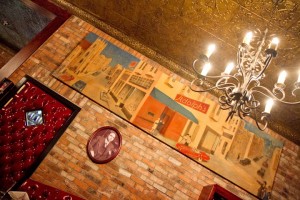
Adolf Restaurant mural
Rarely seeing Chicago specialties, mostaccioli or conchiglie ($12 in pesto or tomato sauce, $13.50 in meat sauce), on West Coast menus, Tony’s mostaccioli is a beaut. Appropriately cheesy, baked in a wood-fired oven, red meat sauce seals the deal. Quattro forni ($13), Capo’s signature dish, is limited to 20 a day due to the preparation required and well worth ordering. Like a glorified garlic bread, or as a waitress described it, doughnut, puffed bread is cooked four times in different ovens, doused in tomato sauce, mozzarella, garlic.
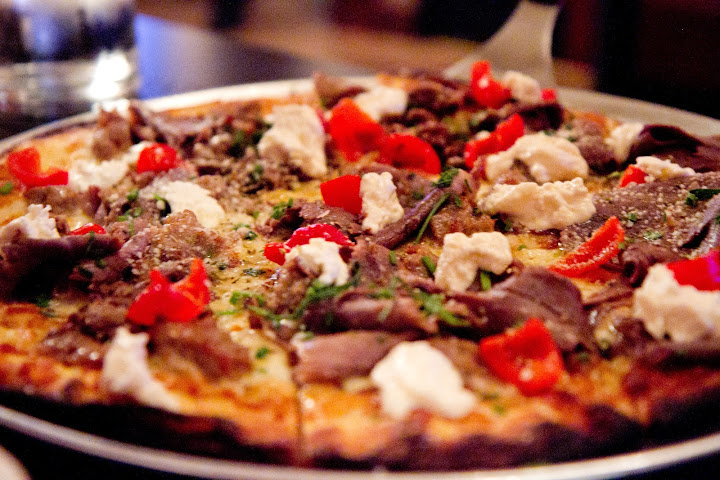
The Italian Stallion, cracker thin
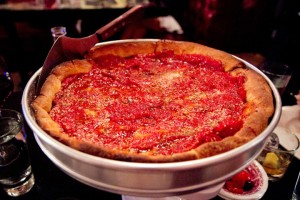
Reveling in deep dish
Then there’s the pizza. While I’ve savored excellent thin crust in Chicago, even after multiple tries at original locations of legendary chains or solo favorites, I’ve yet to find deep dish remotely comparable to Capo’s or Bay Area deep dish havens, Zachary’s and Little Star. I won’t give up the hunt, but thus far eating deep dish here is better than going to Chicago (though I’d happily eat my way through Chicago any day, one of our country’s great food cities).
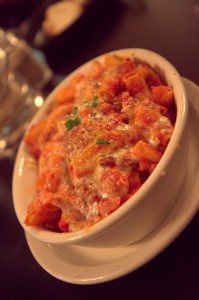
Baked mostaccioli
Appropriate to Chicago, there’s four types of pies: deep dish ($21-33), cast iron pan ($21-33), stuffed ($23-35) and cracker-thin ($17-20). You can’t go wrong. Meat blissfully dominates most pies (unless you build your own), whether folds of Italian beef, thinly shaved in authentic Chi-town fashion, or house fennel, Calabrese and Italian sausages, shown off in the likes of the Sam Giancana or Old Chicago pies.
The Italian Stallion pizza, which I prefer in cracker-thin form, showcases Chicago-style Italian beef, heightened by a drizzle of horseradish cream and insanely good sweet-hot peppers you’ll find on a number of Capo’s pies. Flour-based crust gets texture and complexity from a dusting of cornmeal, while Tony reveals a key to its perfection: European butter and a bit of lard. Fresh cheese oozes, unlike chewy wads of low-quality mozzarella I’m faced with in some of Chicago’s venerable deep dish houses. If you have room and a warm whiskey crisp is available for dessert, get it.
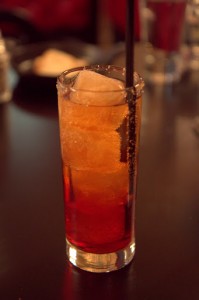
The Silencer cocktail
Elmer Mejicanos heads up a whiskey-centric bar program, housing over 100 American-dominant whiskies, while Tony mentions finding a few antique whiskey bottles dating back to the 1920’s in the basement (when are we pouring?) Building your own Old Fashioned is a key menu focus, alongside a short-but-sweet cocktail list ($12). Trying every one on the menu, I’ve re-ordered only The Silencer. Carpano Antica takes the form of ice cubes melting in Campari, Seltzer Sister Soda and crystals of brandy – an ideally bitter, bright aperitif. A glass of Chianti or Montepulciano is well-suited to all that red sauce – Tony’s longtime business partner Marni McKirahan runs the wine program, also highlighting rare Midwest (Michigan, Chicago) wineries.
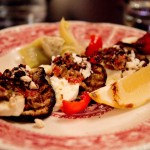
Eggplant Caprese
If I seem to be gushing, perhaps I am. Visiting three times in the first month alone and many time since, I’ve tried every listed pizza and cocktail on the menu. Some openings are exciting, fresh, visionary. A spare few respect the past, even perfect it. The comforting kind you want to return to with family and friends and hope stay around forever. Capo’s is the latter.

Capo’s take-home box sports a drawing of Capone
